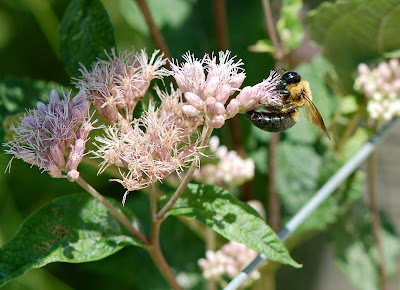 |
| The eastern carpenter bee is about an inch long, with a shiny black hairless abdomen that distinguishes it from bumblebees. |
It's no coincidence that I find carpenter bees and tiger bee flies in the local park.
Carpenter bees are solitary bees, which means that they don't live in hives like the social honeybees that we normally picture when we think of bees. They are called carpenter bees because they make tunnels in wood. Typically, a female carpenter bee uses her strong jaws to evacuate a tunnel in weathered unpainted wood. She makes a round hole about one-half inch in diameter, and digs in as deep as ten inches. Then she goes to forage for pollen and nectar. When she returns, she shapes pollen into balls that we call beebread. She places a ball of beebread at the end of the tunnel and lays a single egg on it, and then she seals it off with a wall of chewed wood pulp. She provisions six to ten chambers in a row, each with a single egg and a ball of food. When the eggs hatch into larvae, they eat beebread until they become pupae.
 |
| A carpenter bee near the entrance to a tunnel nest. |
New adults emerge at the end of summer, chewing through the soft chamber walls. They do not mate just then; they feed on pollen and nectar and return to spend a quiet winter in the tunnels. The next spring they come out to mate, and the cycle begins again. There is usually just one generation a year, except in warm southern places. They may make nests in human structures -- sheds, porches, roof overhangs, even outdoor furniture -- but they rarely cause anything more than cosmetic damage except when their nests are expanded extensively through repeated use.
I often see carpenter bees foraging in the flowers at Brooklyn Bridge Park by the East River in New York City. But what's with this tiger bee fly?
 |
| The tiger bee fly, Xenox tigrinus, seems to have more than its share of names. Tiger is for the patterned wings. Fly because it's a fly. Bee because it preys on bees. |
Tiger bee flies hunt for carpenter bees! When a female tiger bee fly locates a carpenter bee nest she may lay eggs at the entrance. The eggs hatch into larvae that find the carpenter bees within. Tiger bee fly larvae usually wait until their prey is in the helpless pupal state, and then they eat it. Notice that the tiger bee fly in the picture is visiting the kind of untreated unpainted wooden post that carpenter bees like to tunnel in.
It reminds me of this nursery rhyme:
Big fleas have little fleas,
Upon their backs to bite 'em,
And little fleas have lesser fleas,
And so, ad infinitum.
And the great fleas, themselves, in turn
Have greater fleas to go on;
While these again have greater still,
And greater still, and so on.
 |
| See the light colored patch on this carpenter bee's face? That's how you can tell it's a male -- females don't have that mark. |









